You open the tap, and the water flows lazily. The gas column does not turn on, the washing machine does not work. Taking a shower is a problem. The reason for all these troubles is the lack of pressure, or, speaking technically, insufficient excess water pressure. In the article, we will look at ways to increase the water pressure in the house.
By the standards water supply in houses of low-rise buildings, water must flow with excess pressure of more than 1 atmosphere (atm), and this is at the maximum planned amount of water. For each floor above the first one, 0.4 atm of excess pressure is added. Thus, if according to the general plan your building area is listed as one-story, then you have the right to demand from communal services not less than 1 atm when entering the house, if two-story buildings - 1.4 atm, if three-story buildings - 1.8 atmospheres and so on - the higher , the excess pressure should be greater. In reality all this is often not observed. And it is difficult to demand that utilities fulfill these standards in the private sector. Utilities are required to supply water for domestic consumption, and water for irrigation in water supply projects is not taken into account. Accordingly, it is not enough.
But not only excessive water consumption causes low head pressure. In the old water supply networks, the pipes become embedded inside the sediments, which precipitate out of the water, and the actual flow cross-section of the pipelines decreases. Sometimes the pressure in the village is provided by a water tower, and its height is insufficient to create a normal pressure in the areas above the relief. In addition, it happens that the hydraulic resistance of the highway is too high, for example, if the water intake and its pipelines were built long ago, and then the populated point increased, and the supply distance became larger. Wear of the central pumping station equipment also causes low head pressure.

All causes of low excess pressure fall into two categories:
- Water is objective in abundance, but its pressure is low. This happens when the height is insufficient water towers and defective water supply station pumps.
- Water comes a little. This situation arises when water is analyzed for irrigation, littered pipelines, wells with low water reserves, and so on.
The decision depends on your specific case. Let's consider both variants.
Water is enough. How to increase the pressure
The simplest and cheapest option is the installation of a flow-through pressurizing pump. He uses the water distribution system in front of him as a reservoir of water. If we open the water tap, water begins to leak through the pump. The flow sensor detects this and turns on the booster pump. For the consumer it looks like this: first a small trickle of water flows from the tap, but after 2-3 seconds the head increases to the required level. Flow pumps can be installed on the entire house, as well as on individual cranes and appliances, for example, in front of the gas column.
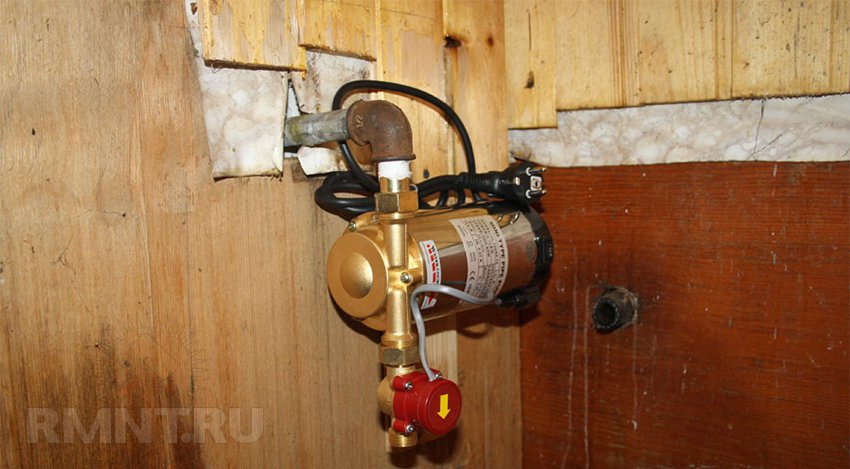
The booster pump is inexpensive and easy to install, but if you have a washing machine, it will not help. The automatic washing machine has a valve set at the appropriate pressure on the water inlet. When there is no pressure, the valve does not work, water does not flow through the pump, and it does not turn on. There are also dishwashers and some types of gas columns and storage heaters. For the operation of such devices, a constant high water pressure in the system is necessary. For this, a hydraulic accumulator is used. Sometimes it is also called a "hydraulic tank" or an "expansion vessel", but this is an incorrect name.
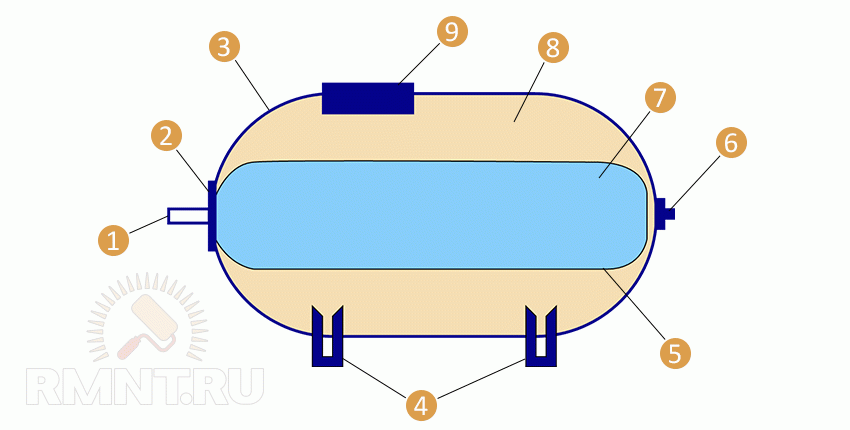 The device of a hydroaccumulator: 1 - a threaded connecting branch pipe; 2 - flange; 3 - housing; 4 - support legs; 5 - elastic membrane; 6 - the air valve; 7 - water; 8 - compressed air; 9 - bearing plate for the pump
The device of a hydroaccumulator: 1 - a threaded connecting branch pipe; 2 - flange; 3 - housing; 4 - support legs; 5 - elastic membrane; 6 - the air valve; 7 - water; 8 - compressed air; 9 - bearing plate for the pump
The accumulator consists of a strong steel body, inside which there are two cavities - air and water, separated by an elastic membrane. In the air cavity there is compressed air (1.5-2 atmospheres). Water is pumped into the water cavity by the pump, its pressure is higher than that of the compressed air. Air is compressed even more, and water occupies a part of the volume of the accumulator. A non-return valve adjusted to 6-7 atmospheres does not allow water to return to the system. The pressure switch connects the accumulator to the discharge pump.

How it works: the pump through the check valve pumps water into the accumulator until the excess pressure in the system reaches the desired value (usually 6-7 atmospheres). When you open the tap or turn on the water appliance, water begins to flow under high pressure. The water from the accumulator is consumed, the pressure in it falls. After reaching the minimum pressure, which is set to 0.6-1 atmosphere above the primary pressure of compressed air, the pressure switch is activated, it turns on the pump. The pump runs until the water pressure again reaches the maximum, and then turns off. Then the cycle repeats.
The pump is connected less often if the volume of the accumulator is large enough and the pump will last longer. When choosing a hydraulic accumulator, it should be taken into account that only half of its nominal volume is used for water supply.
Few water. What to do
If the water is objectively small to ensure a normal head and the required flow - there is no other option, except for the inclusion in the water supply scheme of the intermediate storage capacity . The appropriate volume of capacity is equal to the consumption of water in your home for one or two days. It is quite simple to calculate it: washing up dishes and cooking consumes up to 100 liters of water per day, one shower is 70-120 liters, the toilet leaves 50-60 liters per person, and a bath is 150-350 liters. In most cases, a sufficient volume of storage capacity is 1-1.5 cubic meters.

Suitable material for the storage tank is food grade stainless steel, food grade aluminum or food grade plastics. Install tanks usually in the attic of a house or in a basement. Plus, when installed in the attic - water will flow by itself even if the power is cut off. Less is a high load on building structures and the need for thorough insulation. In addition, leaks are fraught with serious consequences, because the entire tank can merge. If the container is located in the basement, in the event of a power outage, you will have to visit it with a bucket.
 Water supply with storage capacity: 1 - well pump; 2 - the non-return valve; 3 - shut-off valve for filling the tank; 4 - mesh filter; 5 - the electric valve; 6 - float valve; 7 - water intake valve with check valve; 8 - pump station with accumulator; 9 - mesh filter; 10 - electric float; 11 - valve for disconnecting the pump unit; 12 - valve for direct water supply
Water supply with storage capacity: 1 - well pump; 2 - the non-return valve; 3 - shut-off valve for filling the tank; 4 - mesh filter; 5 - the electric valve; 6 - float valve; 7 - water intake valve with check valve; 8 - pump station with accumulator; 9 - mesh filter; 10 - electric float; 11 - valve for disconnecting the pump unit; 12 - valve for direct water supply
The storage tank at the main water supply is equipped with a float valve - about the same as the toilet bowl. In case of water supply, a float level switch is installed from its own well, which includes a borehole pump with a low water level in the tank and switches it off when it reaches the maximum level. If the well has a small debit, a second control loop is connected, allowing the downhole pump to be activated on command from the tank only at a sufficient level of water in the well, and turning it off if the water mirror falls below the allowable one. Both relay branches are put into the switch, which ensures the correct operation of the system. Usually the filling of the tank takes place at night, and in the afternoon the tank is emptied.
We hope, now you can determine the system you need and build it yourself.
One of the systems that create comfortable conditions for life is water supply. On how it functions, depends on the performance of some household appliances, and also whether we can normally take water procedures. About what should be the pressure of water in the water pipe and how to increase or decrease it and we will talk.
Water pressure: standards and reality
In order to function properly plumbing and household appliances, water supply is required with a certain pressure. This pressure is usually called the water pressure. I must say that different pressures are required for different types of equipment. So the washing machine and dishwasher, shower, taps and mixers operate normally at 2 atmospheres. For the work of a whirlpool or with hydromassage, no less than 4 atm is required. So the optimal water pressure in the water pipe is 4 atm or so.
For household appliances and sanitary equipment there is still such an indicator as the maximum allowable pressure. This is the limit that this equipment can withstand. If we talk about a private house, then you can not pay attention to this parameter: your personal equipment works here and above 4 atm, well, a maximum of 5-6 atm. Above in such systems the pressure simply does not happen.

Units of pressure measurement - recalculation and ratio
For the networks of centralized water supply, the standards set the working pressure of water in the water supply of the apartment building - 4-6 atm. In reality it ranges from 2 atm to 7-8 atm, sometimes there are jumps up to 10 atm. Very much it rises after or during the repair work, and this is done specifically. There is a so-called crimping - checking the reliability and tightness of the system with increased pressure. With the help of such a check, all weak points are identified - leaks appear and they are eliminated. The unpleasant moment is that some appliances may have a lower limit of strength, as a result they will also prove to be a "weak spot", and their repair usually costs a lot.
It happens in the high-rise buildings and the opposite situation - the water pressure in the water pipe is too low. In this situation, household appliances simply do not turn on, and a trickle of water flows from the tap. This situation can occur during peak times - in the morning and in the evening, when the majority of residents use the water supply. Approximately the same situation can arise in dachas or in private houses connected to a centralized water supply. The solution to this problem is, and not one.
Ways to increase the pressure in the aqueduct
Low water pressure though not as dangerous as excessively high, but it is very unpleasant - washing under a thin stream of water is very inconvenient. In addition, household appliances do not work, which also does not bring joy. There are two ways to increase water pressure:
- install a boost pump;
- to put the pumping station.
If the installation of the raising pump can still be considered in the apartment, then the pumping station is unlikely to be put. Cut it into the water pipeline is a dubious idea, and it's often just nowhere to put a storage tank for a couple of cubes. True, if necessary, there is a place for everything - if only the water was going with a normal head.
If low pressure is present only in your apartment, most likely you have a clogged filter that is standing at the entrance and it must be cleaned. There is a second option - the pipes were hammered. Then you will have to change them.

If the pressure is low on the entire riser or even in the house, it is worth turning to the management campaign. If calls and verbal requests do not help, you can write a collective letter. It is signed by all tenants, taken to the Criminal Code and registered. The letter must be in two copies. One remains in the Criminal Code, the second - with a stamp and affixed incoming number and the date of receipt - from someone from the tenants. In theory, you should be given an answer within a month or take measures to fix the malfunction. If there are no actions, this letter can be addressed to the Committee for the Protection of Consumer Rights.
Pump for increasing water pressure
This equipment raises the existing pressure in the network by 1-3 atm. Put in the rupture of the pipeline. It is usually cut right after the counter, ensuring the stable operation of the water taps. If you also need to ensure the normal functioning of household appliances (washing machine and dishwasher), then the pressure boosting pump is placed directly on the branch leading to the technique.
How does he work? It turns on when there is a flow (the tap is opened or the machine starts to draw water). Disconnects if the water flow stops. This is how automatic models work. But there are manual or combined - which can work in both manual and automatic mode. Manual are not too convenient and economical, although they are cheaper. But the combined can come in handy if there is a need to raise the pressure, but it is above the limit of operation of the pump. Then you can force it manually.
How to lower the pressure in the aqueduct
To ensure the entire technology normal operation and stable pressure, it is desirable to put the reducer. This is a small device that is placed after the coarse filter (with a large cell), but before the fine filter (with a shallow cell). It neutralizes the pressure jumps in the water pipe, "cutting off" the excess of a certain threshold.
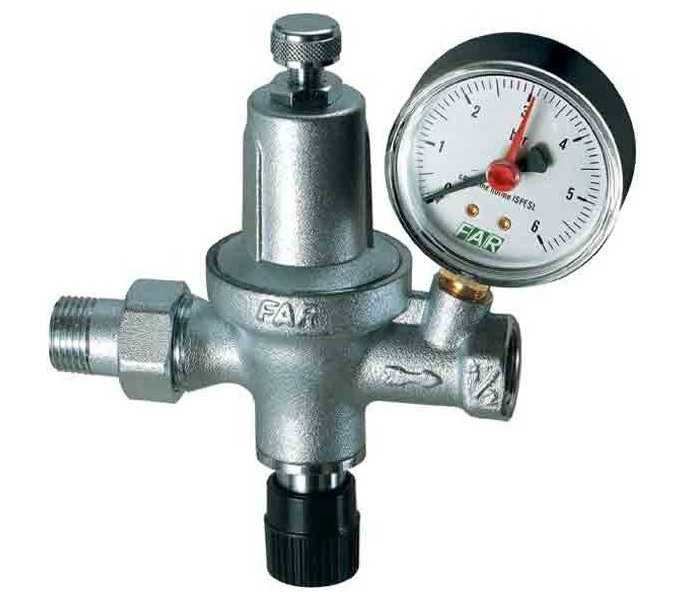
The water pressure reducer is a device for lowering and stabilizing the pressure in the system
Pressure reducers are many different, they should be chosen depending on the situation. Selection Criteria:
- Maximum pressure in the system should not exceed the passport pressure of the reducer.
- That the device could work in the range you need.
- It is necessary to take into account the minimum pressure at which the gearbox starts working (from 0.1 bar to 0.7 bar).
- The temperature of the medium with which the device can operate. For installation in a hot water supply system, a temperature of at least 80 ° C is required.
- How can it be located in space. There are models that are installed vertically, there are - horizontally, there are universal, but they are more expensive.
More expensive models of water pressure reducers can have built-in pressure gauges or filters. If you do not have these devices, it may be worthwhile to purchase such a combined device. But, according to the experience of operation, it is easier to service individual devices (the exception is a manometer, it can be built-in).
Add to bookmarks
About water pressure in pipes
Water supply of a private house
The main causes of failure of the water supply system in a private home are corrosion, salt deposition or increased pressure. If we take into account that in recent years instead of metal pipes in newly built houses and cottages are mainly used plastic pipes that are not susceptible to corrosion, there are only two reasons for the failure of the water supply system.
Scheme of water supply of a private house: 1. Submersible borehole pump. 2. Caisson. 3. Accumulator with pressure switch. 4. The pump control unit. 5. Mechanical cleaning filter. 6. The filter is deferred. 7. Filter softener. 8. Mechanical safety filter. 9. A solution for regenerating the softener. 10. Ultraviolet sterilizer. 11. Water heater. 12. Drinking water treatment system. 13. Local treatment facilities.
Purchasing pipes, on the technical passport on them, make sure to what allowable pressure they are calculated and what pressure it is recommended to actually maintain in the system where they will be applied. Take into account that an unjustified increase in pressure in the water supply system due to an increase in its operation will lead to unjustified energy costs for the pump that supplies water to the system.
Water pressure in the water supply system
The construction organization, with which they conclude a contract for the construction of a cottage, will probably offer their services for the installation of a water supply system. Before agreeing, ask if she has experience of doing such work and how many have already been done. Do not be lazy and talk with the owners who used to use the services of this organization.
An important indicator in the water supply system is the working pressure in the pipes.

So, for normal operation of the crane in the kitchen, the average pressure should be at least 0.5 bar. Depending on the type of pipeline and pipe material, the pressure in the system may slightly differ from the average. When accepting the water supply system, be sure to check the operating pressure in the system and whether it meets the specified requirements.
If you plan to install the system yourself, then before starting work, it is necessary to get acquainted with the basic requirements for water supply systems and the rules of its installation, which will ensure the fulfillment of these requirements.
Accumulators and expansion tanks
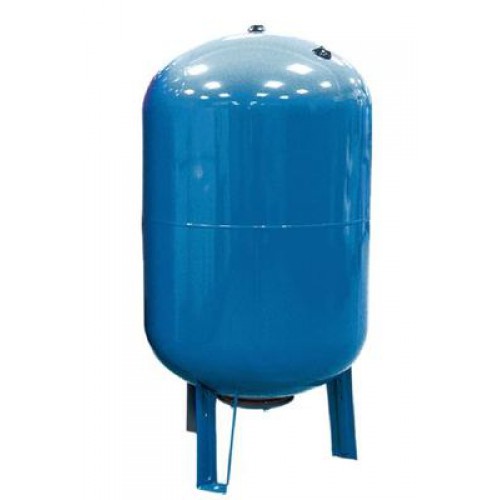
Probably, the estate will provide not only a water supply system at home. When designing a water pipe, it is necessary to provide for the fire-extinguishing system, hot water supply, filtration of waste water. There will be a separate sleeve for watering the garden, and, certainly, the heating system. In the water supply system itself, in fire extinguishing and filtration systems, hydraulic accumulators must be installed, and in the other systems expansion tanks. In addition, in the hot and cold water collection points and at the hot water outlet, expansion tanks should be installed from the heating system boiler to compensate for possible water hammers.
Expansion tanks in the hot water supply system, as well as safety valves, are designed to protect the boiler from overpressure. In the fire fighting system, hydraulic accumulators are used to store additional water in case of fire. In the system of domestic water supply, the accumulators must be designed for pressure up to 6 bar, which corresponds to a rise in water up to a height of 60 m.
Earlier it was said that the heating system should be equipped with protective devices. We consider it necessary to tell about this in this article.
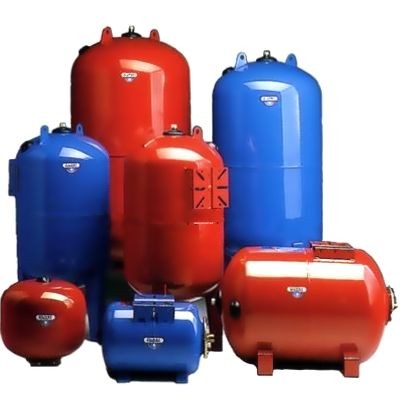
Hydroaccumulators come in different sizes, so before you start creating a water pipe, you need to determine what size of the accumulator you need.
In the heating system, the heat transfer medium coming from the return to the boiler for heating, with a change in temperature for every 10 ° C, increases in volume by 0.3%, that is, for example, when the heating medium is heated by 70 ° C, its volume will increase by almost 3 %. Due to the fact that the liquid is incompressible, such expansion, in the absence of a compensation expansion tank, will necessarily lead to the destruction of the pipeline. It is not recommended to install an open-type compensation tank.
Such a tank makes the heating system open, that is, operating at low pressure, and, therefore, low-control. In it, the coolant evaporates. Due to the access of oxygen through the open tank, metal pipes are more intensively corroded. The closed compensator can be installed in any place of the heating system, and the open compensator can be installed only in its uppermost part, therefore, the tank must be insulated. All this makes the open tank an expensive treat.
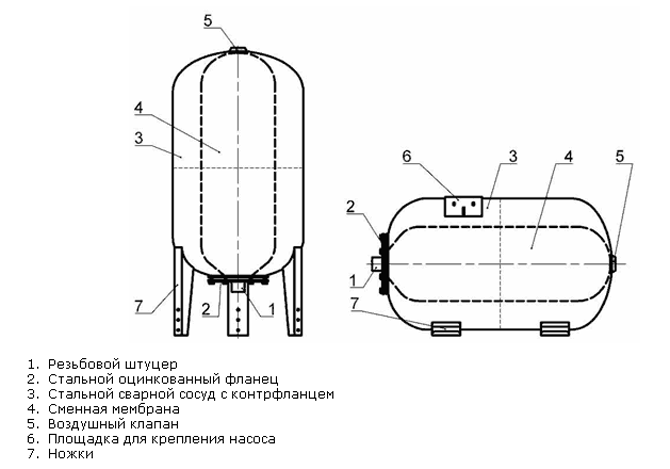
In hydraulic accumulators a certain water reserve is created, which, if necessary, can be fed into the water supply system. They can be closed or open type, and all the disadvantages of the open-type compensation tanks, indicated for the heating system tanks, are also inherent in open accumulators. Tanks provide protection of the water supply system from a dangerous phenomenon for it, which is a hydro shock. Hydraulic hammer can occur when the power supply to the pump motor is abnormally shut off, as well as when the water tap is opened and closed sharply.
In this phenomenon, the dynamic loads that arise can repeatedly exceed the static loads calculated for a particular water supply system. In places of water extraction it is recommended to install small expansion tanks of standard capacity equal to 0.2 liters.
Hydraulic accumulator design
The main element of the closed-type accumulator is a membrane.
The principle of the membrane inside the tank is as follows. The membrane chamber inside the tank is filled with air. When the pump is first switched on, as the tank is filled with water, the volume of gas in the membrane cylinder decreases, and its pressure increases accordingly. This force is transferred to the relay pressure, which controls the switching on and off of the pump. The relay is designed for a certain amount, exceeding which leads to the shutdown of the pump.
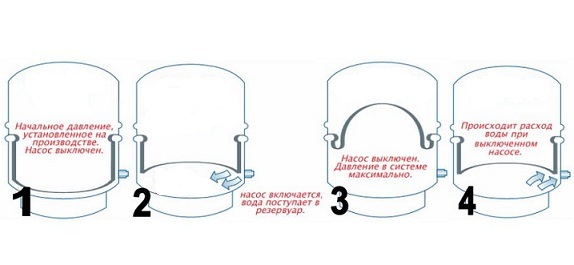
With the natural selection of water from the water supply system, the pressure decreases and the relay switches on the pump again. If in the system the pipeline tightness is broken and the pressure is less than the set value, then this relay, having normally open contacts, will not turn on the pump. To prevent an emergency, a relay with normally closed contacts will shut down the pump if the pressure in the membrane part of the tank exceeds the set maximum value.
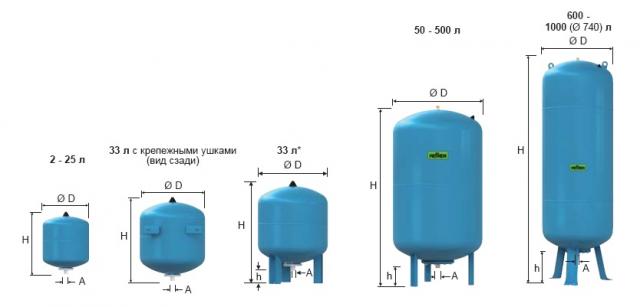
Correct selection of the volume of the accumulator significantly influences the duration of its operation, for this determines the frequency of operation of the membrane. Practice has established the following: if there are no more than three water collection points in the water supply system, one hydro accumulator with a tank of 24 liters is sufficient; if there are more than 3 sampling points, a tank of 50 liters capacity is sufficient. If the house has a sewer, bathroom and other devices that consume water, then you need to calculate the volume of the tank.
Note. With a distance from the water level to the accumulator, not exceeding 8 m, it is possible to use the pumping station, which will provide both water supply and pressure regulation in the water supply system. A pumping station, equipped with a pump with an injector, will ensure the delivery of water from a depth not exceeding 40 m.
Water pressure in pipes
Calculation of pressure

To measure the pressure in the pipes, you can use a manometer to measure the water pressure in the water pipe.
We denote the maximum and minimum pressure in the membrane volume of the tank as Pmax and Pmin, respectively. Their difference, ΔР, will be proportional to the maximum volume of water coming from the accumulator. The greater the difference, the more efficient the operation of the accumulator. But it should be borne in mind that as the ΔP increases, the probability of rupture of the membrane increases.
The air pressure in the membrane chamber should ensure that the water rises to the maximum height of the pipeline in the cottage. If this height is 10 m, then the corresponding pressure is 1 bar. The minimum pressure to start the pump must be 0.2 bar higher, that is Pmin = 1.2 bar.
In order to ensure reliable water withdrawal at the highest point of the discharge, we measure the distance from it to the location of the accumulator (for example, 10 m or 1 bar) and take into account that the pressure drop in the crane must be at least 0.5 bar. That is, Pmin = 1 + 0.5 = 1.5 bar, not 1.2 bar, as previously defined.
To determine Pmax, it is necessary to start from the pressure characteristic of the pump, take into account the hydraulic resistance of the pipeline, take into account possible variations in the network voltage that affect the pump's performance, and take into account the change in pump capacity during operation.
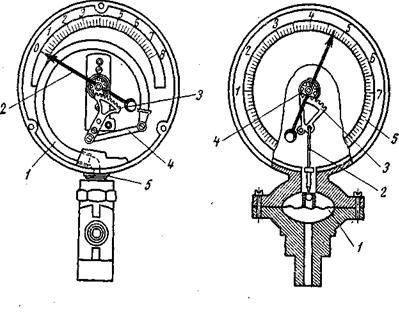
Scheme of a spring (left) and a membrane (right) manometer. Spring; 1. Hollow tube, 2. Arrow, 3. Gear segment, 4. Lever; 5. Fitting. Membrane: 1. Membrane plate, 2. Rod, 3. Toothed segment, 4. Toothed wheel with arrow, 5. Dial.
This is a rather complicated calculation, but it has been proven by practice that in water supply systems of buildings such as cottages, it is sufficient that ΔР be equal to 1 or 1.2 bar. Hence: Pmax = Pmin + 1.2 = 1.5 + 1.2 = 2.7 bar. It is also recommended that the maximum head is 30% less than the pump head. Therefore, based on the calculation performed, it is necessary to choose a pump that provides a minimum water head equal to: Рnас = 1,3 Рmax = 1,3 ∙ 2,7≈3,5 bar. Determine the pressure in the system, using a manometer.
It is desirable to measure the dynamic pressure, that is, the pressure during the movement of water through the pipes. To do this, they should be as open as possible, at least two cranes, and of them water must flow. Large changes in dynamic pressure during the day indicate some deviations from the normal functioning of the water pipe. The pressure in the hot water system depends on the water temperature and can differ significantly from the dynamic pressure of the cold water.
Measuring the pressure, one should also take into account the error that the measuring device allows. The error depends on the class of the instrument that indicates the instrument. For example, a class of 0.6 is considered high, which corresponds to the limits of the permissible error of 0.6% of the instrument reading. For household needs, class 1.5 is sufficient.
Instructions for use
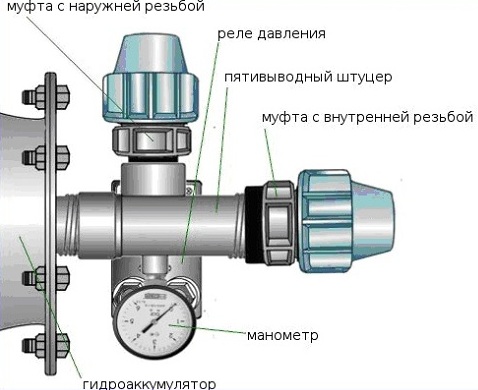
Verification of the health of the system and the state of the equipment must be carried out at least once a year. First check the presence of leaks. After eliminating them, the pressure is checked from the manometer on the main (lower) accumulator. It must be equal to Pmin. If the pressure is less than the required value by more than 10%, then with any compressor we increase the pressure to the value at which the on-off relay should turn on the pump. At the moment of tripping of the relay (pump shutdown), we measure the opening pressure.
It should not differ from Pmax by more than 10%. Now open one of the cranes and again check the pressure at which the pump turned on, and, closing the valve, we fix the pressure at which the pump is turned off.
Danger of hydraulic shock
A few more details need to be told about the causes of the impact and its consequences. The water moving in the pipes, like any mass, has inertia, and as a result of a sharp overlap in the path of movement, the fore layers begin to thicken under the action of the mass of water that is still moving.
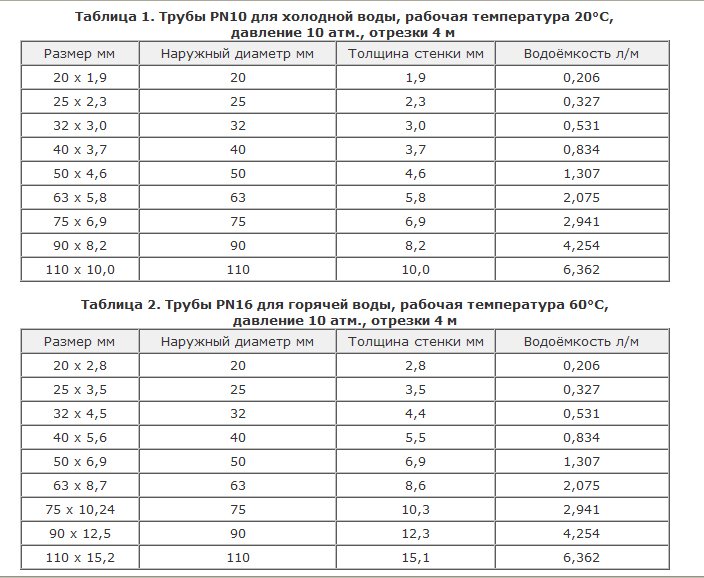
Table of pipe diameters for hot and cold water.
The pressure of water on the walls of the pipes (shock wave), increasing, gradually moves in the pipes in the direction opposite to the movement of water. When the compression process stops, the process of shock wave movement in the opposite direction will begin. Without giving the calculations, we note that the velocity of propagation of the shock wave depends on the pipe material, its diameter and thickness. For example, in cast iron pipes with a diameter of 50 mm and a thickness of 7 mm, the propagation velocity is 1348 m / s, and in pipes with a diameter of 600 mm and a thickness of 18 mm, the velocity is 913 m / s.
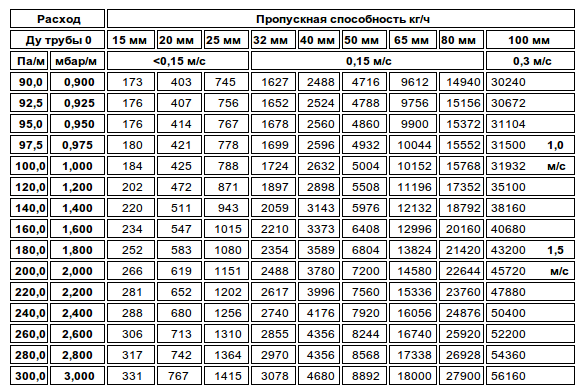
For comparison, the speed of propagation of the shock wave in rubber tubes is only 30 m / s. It is interesting to know not these quantities, but the consequences arising after the impact of a shock wave, for example, on a pump. The situation is quite real: stopping the pump, which pumps water into the tank above it. Continuing upward movement, the zone of increased density will be removed from the pump, and near it a space is formed in which water will be less dense.
Further, reflecting from the reservoir, the zone with increased density will return to the pump. If you do not provide protection in the form of a check valve, the pump will start to rotate in the opposite direction. Here lies a new danger, that if the check valve closes very quickly, then a shock wave will appear again, but spreading in the opposite direction.
To exclude the occurrence of a backward wave, the closing time of the valve (T) must be commensurate with the wave travel time before and from the reservoir, that is, T = 2L / V, where L is the distance from the pump to the tank, m; V is the velocity of propagation of the shock wave, c, which, as we know, depends on the material and dimensions of the tubes, and for the flexible hose is 30 m / s. To reduce the rate of operation of the check valve, the damper valves are used.
Many residents associate the water supply system with a number of pipes located in the walls and taps, turning which water comes in. And also most people have no idea about all the complexities of the communication network.
The working pressure in the water supply system is one of the main indicators of the effective operation of the water supply system. All plumbing devices can function normally only with a stable water pressure.
A weak pressure, representing itself as slowly flowing water from the tap, indicates a low pressure in the communication network. In particular, this factor worries the citizens who own flats on the upper floors and residents of country houses.
A weak head stops the work of washing machines, dishwashers, shower cabins and baths. This article will discuss the issues of pressure standards, the maximum and the minimum acceptable level.
Normal performance
The unit of pressure in the pipes of water supply in an apartment and in a private house is 1 bar, which is equal to 1, 0197 atmospheres. This figure is fully consistent with the mass of the water column at a height of 10 m.
The communication network requires a working pressure of 4 bar, which in turn corresponds to the weight of a column of water 40 meters high.
This indicator will provide water to consumers of all floors, including the highest ones. But it should be noted that the stability of the indicator is extremely rare. Moreover, the pressure of the 4 bar is not so common. Typical water supply system implies a pressure in the range of 2.5-7.5 bar.
Strong pressure and accordingly increased pressure index leads to malfunctions in the water supply system, moreover, some plumbing devices are damaged at a rate of 6.5 bar.
And even more pressure is not able to withstand 10 atmospheres by virtue of only welded joints and fittings for industrial use, differing in conical thread. Just as high and low pressure leads to malfunctions and malfunctions in the water supply system.
Some plumbing equipment starts to work at a certain rate, for example, a jacuzzi will function only at 4 bar. Shower and washing machine will require a pressure of 1.5 bar.
In view of these features, a normal indicator is 4 bars. This boundary has minimal risks of damaging the joints of pipes and assemblies and is sufficient for the operation of various plumbing fixtures. 
Pressure for a water system of an autonomous type
The autonomous water supply system operates in a completely different type and the standard generally accepted norms are not of particular importance here.
In this water pipe, you can set any pressure indicator, starting from the minimum allowed, at which water flows almost by gravity (1-6 bar). In the case of autonomous water supply, the owner decides everything here.
The minimum allowable pressure for a country house is 1.5 bar. It allows at least two plumbing devices at the same time. The maximum permissible value depends on the characteristics of the water source and the capacity of the pumping equipment.
But most of the residents of country houses are concerned about the problem of low head, so many are interested in ways to increase the pressure in the water supply system. 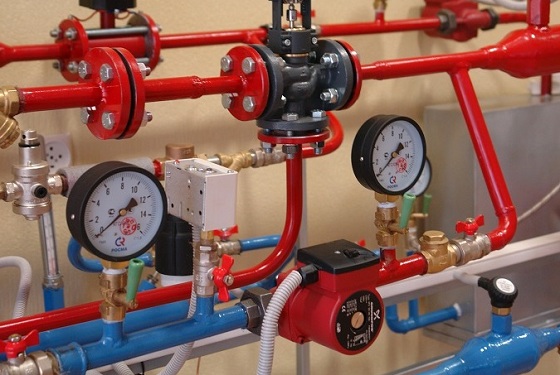
The ways to increase
Increase the pressure in the autonomous water supply by technical means: with the help of a storage tank or pumping equipment. These methods have their advantages and disadvantages.
Pump equipment
This method is suitable for apartments with a central water supply system and for country cottages, suburban areas with autonomous water supply. Additional pumping equipment is only used if the main unit does not fulfill the required requirements.
This is possible with the remote location of the well or inadequate power of the appliance to supply water to the second floor. An additional pump is installed at the entrance to the house wiring.
The device must have a water pressure sensor that starts it at a normal rate and turns it off when there is no user. The most commonly used vibrating pump, which differs weak sensitivity to high air content. 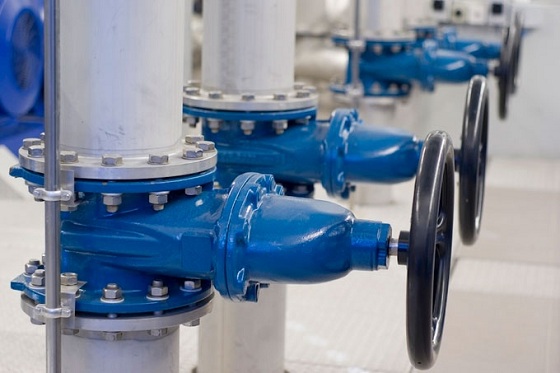
Station with storage capacity
This method works in a completely different way: the pumping equipment pumps water into a storage tank that operates at a stable pressure of 1.5-2 atmospheres. And this means that the liquid is pumped until the required indicator appears, then the pump is switched off.
The water supply system in this case consumes water under the strict control of the pressure reducer, the parameters of which are set beforehand before operation. The pump in this system is suitable, both vibrating and centrifugal.
To inject pressure into the accumulator, an internal or external ejector is used, which creates a vacuum in the pipeline. This method is not used in apartments due to noisy work and some design features.
Working pressure in water supply is an important indicator on which the functioning of most devices depends. But there are methods to improve it, which are applicable in urban and rural areas.
The main characteristic of the normal functioning of water in the system is the presence of optimal pressure. However, it is not always possible to maintain good pressure, especially when there are various devices connected to the water supply system. There are several ways in which you can increase the water pressure. We learn about their features and technology of implementation further.
Water pressure in the water supply system: the optimal value and reasons for the reduction
In order to determine the method of increasing water in the water supply system, it is first of all necessary to find out the cause of the decrease in the pressure of water. Most often, the reasons for the decline of water are:
- presence of leaks or accidents at the place of water transportation;
- the presence inside the pipes of foreign deposits, which interfere with the normal circulation of the liquid;
- the presence of a defective filter that cleans the water;
- problems with shutoff valves.
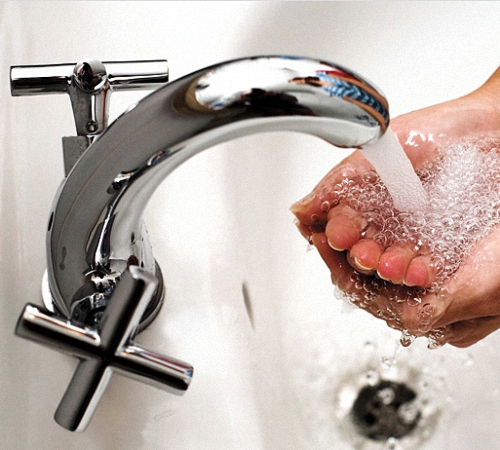
If there is centralized water supply in the house, the pressure of water often decreases because of the poor work of the water transporter. For example, in order to save electricity, one or more pumps are shut off, which improve the pressure. In the presence of pipe damage on certain sections of the pipeline, the water pressure also decreases.
Therefore, if you have a sharp drop in water pressure in the system, first of all ask neighbors, did not arise and they have such problems. If the pressure has decreased not only for you, then contact the water supplier directly in your area. The minimum value of water pressure in a single-story structure should be one bar. This information is recorded in the legal documentation and must be carried out by all utilities.
Between the water supply system that comes to the house, install a pressure gauge, through which you can monitor the water pressure in the system.
If the problem of reducing water in the system only touched you, then it is necessary to check the pumping station for its operability. Most often, a deep filter is clogged, which cleans the water before introducing it to the house.
In addition, you should inspect the filters that provide fine cleaning, they connect household appliances with water supply. Problems with these types of filters lead to improper operation of washing machines, boilers, pumps, etc.
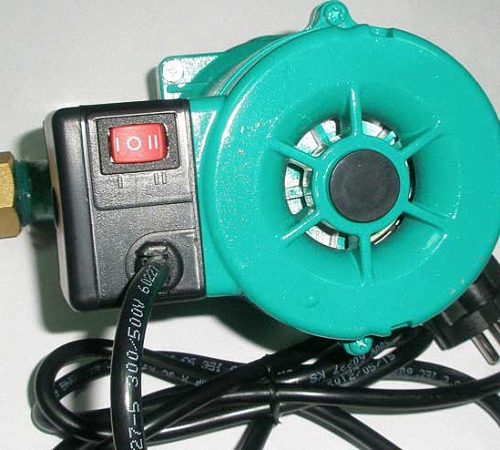
If the filters work properly, go around the house and check the pressure in various sections of the water pipe. A variant of leakage inside the contour is possible. To determine this area, it is necessary to measure the pressure at different sections of the water pipe and determine the lowest value. After eliminating the leak, the pressure should increase.
Pump increasing the pressure in the water supply system: features of choice and installation
First of all, the installation of a pump is an artificial method of increasing pressure. In each system of water supply under pressure, individual pumping equipment is selected, in the selection of which factors such as:
- duration of the backbone system;
- diameter of pipes of the water supply system;
- number of floors in the house;
- amount of water consumed.
When choosing water pressure pumps, pay attention to their performance and power. These indicators are the main factors when buying this equipment. In addition, the pump must be made of high-strength materials that are not prone to corrosion.
There is an option to purchase a booster pump. These models are not recommended for installation in private homes with additional equipment that consumes water.
The cost of the pump to increase the water in the system depends on the capacity of the device. Approximate price of equipment is from 40 to 200 $. Some equipment is equipped with additional automated mechanisms, such as a flow sensor. With it, you can automatically turn on the equipment when opening the cranes.
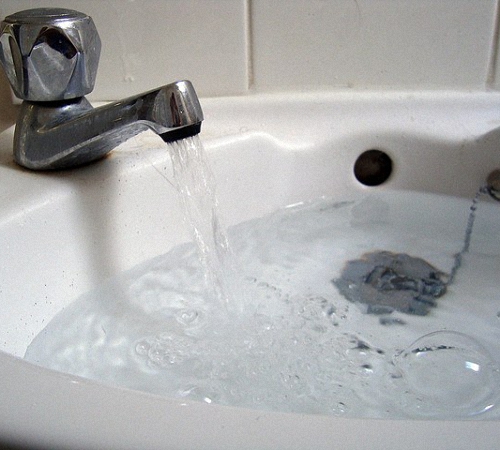
Thus, the level of power consumption in the system is reduced. The cost of equipment is also determined by the degree of its protection against moisture and additional constituents that are present in the water. Pay attention to models with a high-quality filtration system. Aluminum, cast iron or stainless steel is used for manufacturing the body of the device.
We recommend purchasing equipment in a brand store of one or another manufacturer. Buying goods directly you will not only save, but also receive a free warranty and additional maintenance of the device.
Also, when choosing equipment to increase water pressure, pay attention to the difference in models by the way of management:
- devices with a manual mode of operation ensure a constant operation of the device during the whole time, it is necessary to follow the switching on and off of the device independently;
- automatic pumping devices - a flow sensor of such a device regulates the switching on and off of the device, there is also protection from switching on in dry mode, the duration of operation of such a device is higher than that of a hand pump, it also has an economical power consumption, but has a higher cost.

In relation to the type of cooling of the hull part of the pumping equipment, two types of pumps are distinguished:
- when choosing a pump with cooling by means of shaft blades, the sounds that are produced during the operation of the equipment are quite quiet, while the efficiency of the mechanism is at a high level;
- when the pump is cooled with liquid, complete quiet operation is ensured.
An important role in choosing a pump should be given to its size. If the room is small in size, the installation of a huge device will be inappropriate. Some pumps are used only for hot and cold water. Other devices are suitable for any type of water supply.
In general, when choosing equipment, determine its characteristics:
- the purpose of buying a pump;
- principle of operation of equipment;
- characteristics of equipment, most often specified in the instructions;
- the size of the device;
- amount of purchase;
- availability of additional functions.
The main characteristics are the serviceability and pressure that the pump can create in the system. They determine the type of equipment purchased.
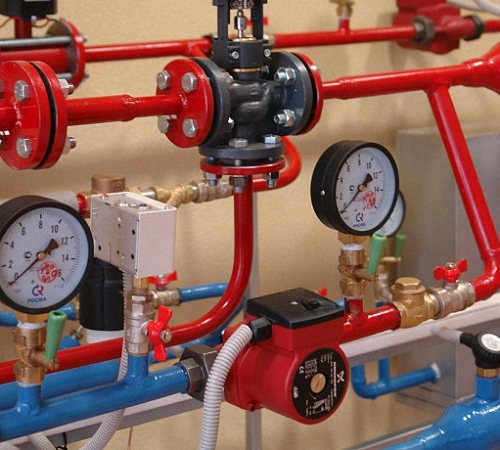
How to increase water pressure in a private house
The water pressure in the water supply system is determined by the number of household appliances using water. For example, if the house has a washing machine, a sink and a bath, then there is enough pressure in two atmospheres. However, if there is a pool in the house or a chic Jacuzzi, this value should be doubled.
In addition, the pressure in the system must be such as to supply water directly to several points of draw-off. Taking a shower and erasing, you should not have any discomfort associated with lowering the pressure.
If the site has a private water supply, that is, the water supply is carried out from the well or from the well, then the pump capacity should be much higher than when supplying water from the centralized water supply.
The performance of the pump must ensure that the water is lifted from the well and fed to the house. At the same time, the house should provide the optimum water pressure in the system. These indicators directly depend on the amount of liquid consumed. The more water is consumed in the house, the higher the pump capacity.

In the process of operation of the private water supply system, there are two options for water consumption:
1. A well is characterized by the presence of production in which there is a weak head or it is completely absent. At the same time, it is possible to satisfy the water needs of two, three people in the family. As the source is quickly emptied, there is a drop in pressure. For these purposes, additional means of modernization are used.
2. The production rate of the well exceeds the water discharge rate for the average statistical family. In the presence of a pump, whose capacity is restrained by pressure, there is an excessive increase in pressure to six atmospheres. Thus, leaks and emergencies are formed.
Choosing pumping equipment for private wells, it is necessary to be guided by the flow rate of the well and the flow of water. We recommend to choose as a reference daily water consumption in the summer.

Ways to increase the water pressure in the house
As methods that increase the pressure in the water supply, we will single out the installation of two devices:
1. Cutting into the water pipe under the pressure of the pump - this operation is performed at the entrance of the common water pipe to the house or apartment. Installing pumps, before the water sampling points, significantly increases the pressure in the system. Compact pumps can automatically or manually adjust their operation. However, this method makes it possible to increase the pressure by a small amount of 1-1.5 atm.
2. It is recommended to install a pumping station to eliminate more serious pressure problems, as well as to organize temporary independent water supply. In this case, a storage tank is installed, the water in which accumulates in advance and is fed into the system by means of pumping equipment.
Pumping station, which has a hydraulic accumulator, requires considerable investments, in addition, for its location it is necessary to prepare a lot of space. You will also need to spend money on purchasing a storage tank, the size of which should be ten times the daily water consumption. However, in this case, you get constant ideal pressure and water supply, even with periodic shutdown of water.
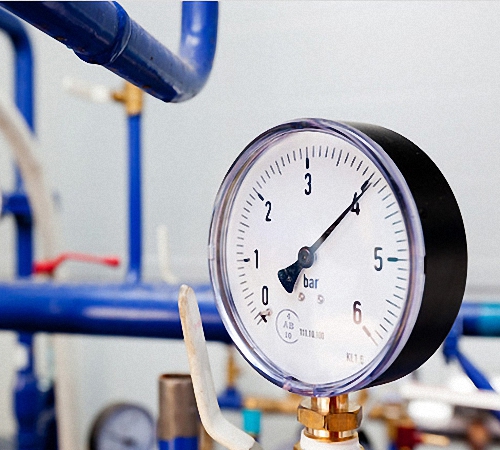
Stabilization of water supply pressure in a private house
Among the main ways to increase the pressure in the system, a pumping station or pump installation is allocated. The first option is relevant in the case when the pressure in the system is practically absent.
The pump station can significantly increase the pressure in the system. The electric piston engine draws air from the water accumulator. The formed vacuum space gets water from a well or a water pipe. The installation of such a station in a multi-storey building allows obtaining a constant qualitative pressure. However, such stations are rather cumbersome and for their installation it is necessary to obtain special documents for the permission to perform work.
If there is a minimum water pressure in the system, it is sufficient to install an ordinary pump in the apartment. It is installed on a pipe that goes inside the apartment. Automatic equipment starts working when the water is turned on, while manual models mean a permanent on and off pump.
To connect the pump to the system you will need a soldering iron, which is designed to connect pipes to each other. On the inlet pipe, the tap of the water supply to a certain apartment is closed. Further, the pipe and the flow sensor are inserted. At the ends of the cut pipes, a connecting armature is mounted on which the pump is screwed together with the sensor. Plug the pump into the mains and open the tap.
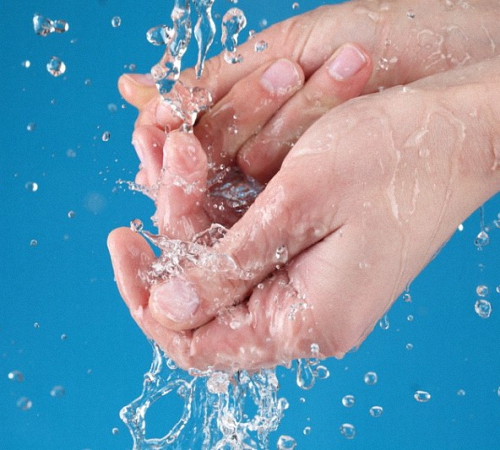
Another option for increasing pressure is to install the pump directly in front of the appliance for water supply. For this, first of all, it is necessary to study the technical parameters of the device, while determining the maximum pressure for its operation.
Next, you need to buy a centrifugal pump, the performance of which is comparable to the maximum pressure. Note that the centrifugal pumps are very similar to the pump equipment installed to circulate the heat carrier in the heating systems. However, the principle of work and productivity are different for them.
In addition to the pump, devices should be purchased in the form of a ball valve and flexible wiring. Note that the diameter of the hose must match the thread of the pumping equipment. It will also require the presence of a tape tape, with its help it is possible to seal the joints.
Begin work should be from the tap of the water supply to the apartment or house. Further, the location of the pump installation is determined, most often it is fixed to the wall using plastic dowels. In any case, before beginning the installation of the equipment, read its instructions.

On the wall, mark the fixing points of the pump and install it. A flow sensor is attached to the pump, which controls the switching on and off of the device. Next, threaded connections are mounted, do not forget to install rubber gaskets. They go with the equipment. The inlet on the pump is connected to the water pipe.
After assembling the device, check its operability. Install the pump and turn on the water, if there are stains, seal the connections with a fumble. Do not forget about the device grounding. Check the operation of the device in automatic mode. Look at the pressure gauge of the pressure in the water pipe. The optimum pressure is 2-3 atmospheres.
